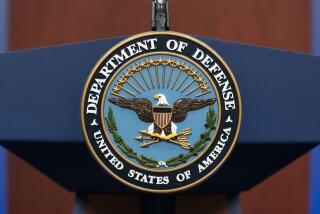Constellation Prepares to Ship Out to Gulf Region
- Share via
WASHINGTON -- An aircraft carrier based in San Diego is preparing to steam to the Persian Gulf region early next month, another in a series of moves the Pentagon has been making to prepare for a rapid massing of U.S. forces around Iraq.
The deployment of the Constellation and its battle group of ships and fighter jets has been scheduled for at least two years, Navy officials said, and has not been accelerated for the U.S. confrontation with Iraq. When it arrives in the north Arabian Sea in mid-December, however, the Constellation will be the third U.S. carrier in the region -- one more than is normally deployed at a time.
Two other U.S. carriers -- the Abraham Lincoln and the George Washington -- and their battle groups are already within striking distance of Iraq. A fourth carrier, the Harry S. Truman, is to head out in early December from its home port in Norfolk, Va.
Maintenance work and air crew training on the Constellation and two other carriers on the West Coast -- the Nimitz and the Carl Vinson -- have been accelerated to prepare them for possible deployment to the Gulf region, Navy officials said. Another carrier, the Japan-based Kitty Hawk, also would be available for action.
The Constellation is due to relieve the Lincoln, now in the north Arabian Sea; the Truman is scheduled to replace the Washington, now in the Mediterranean. But the carriers’ normal six-month deployments could be extended to boost U.S. firepower off Iraq if ordered by commanders, Navy officials said.
The Constellation is conducting training exercises with other ships and aircraft in its battle group off California’s coast.
John Pike, director of Global Security.org, a military research group that tracks deployments, said the Constellation appears to be preparing to leave port several weeks earlier than it normally would. The Lincoln is not scheduled to leave the region until mid-January, Navy officials said.
“Unless they’re planning to take the scenic route, it seems they’re going out weeks earlier than would be required to replace the Lincoln,” Pike said.
Navy officials insisted that the temporary overlap of carriers in the region is routine.
“We have ships returning and ships deploying all the time,” said Cmdr. William Fenick, a Navy spokesman at the Pentagon. “We have to make sure we always have assets deployed on station, on call, for purposes of maintaining deployed readiness.”
Since September, the Pentagon has quietly built up its forces and equipment in countries and waters near Iraq. The buildup has fed suspicions that the Pentagon is preparing a surprise attack. But defense officials dismiss such speculation as unrealistic. Before any military action, they say, the Pentagon would need to mobilize several Army divisions, scores of Air Force aircraft and armadas of ships.
But the measures being put in place would allow U.S. forces to rapidly mount action against Iraq after reaching the region, officials said.
The Pentagon announced last week that headquarters units of the Army’s V Corps, based in Heidelberg, Germany, have been ordered to Kuwait, along with an AH-64 Apache helicopter unit and an aviation task force. The Army contingent has the capability of commanding land forces in a war.
“Select forces” from the 1st Marine Expeditionary Force also are deploying to the region in support of the U.S. war against terrorism, said Marine Maj. Jeff Nyhart, a spokesman at Camp Pendleton.
The Marines will take part in a biennial exercise, dubbed Internal Look and run by the U.S. Central Command based in Tampa, Fla., that is responsible for U.S. military operations in the Middle East.
The command-post exercise, to begin next month, will test communications and control among component commanders. It will be headed by a staff of 600 people who will move from the command’s Tampa offices to a recently completed U.S. Army command center in Qatar. Although billed as a training exercise, the move will allow the establishment of a main command post that could be used in the event of war.
The military buildup has been accompanied by an increase in U.S. airstrikes on Iraqi air defense targets, reflecting what Pentagon officials say has been an increase in Iraqi provocations. But the types of targets also have expanded.
Defense Secretary Donald H. Rumsfeld disclosed last month that he had directed commanders to focus retaliatory strikes on air defense communications centers in an attempt to degrade Iraq’s air defense network.
*
Times staff writer John Hendren contributed to this report.
More to Read
Sign up for Essential California
The most important California stories and recommendations in your inbox every morning.
You may occasionally receive promotional content from the Los Angeles Times.













